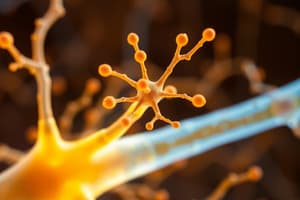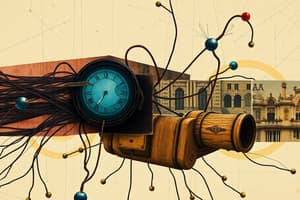Podcast
Questions and Answers
Which of the following is NOT a component of the superficial somatosensory system?
Which of the following is NOT a component of the superficial somatosensory system?
- Touch
- Vibration (correct)
- Temperature
- Pain
Which of the following sensation types is related to muscle contractions?
Which of the following sensation types is related to muscle contractions?
- Visceral
- Deep (correct)
- Superficial
- None of these
Which of the following sensations is NOT part of the deep somatosensory system?
Which of the following sensations is NOT part of the deep somatosensory system?
- Muscle pain
- Joint position
- Vibration
- Temperature (correct)
What type of afferent fibers are associated with the visceral somatosensory system?
What type of afferent fibers are associated with the visceral somatosensory system?
Which of the following is an example of a sensation that can be attributed to the visceral somatosensory system?
Which of the following is an example of a sensation that can be attributed to the visceral somatosensory system?
What is the correct order of sensory pathway for fine touch, vibration and proprioception (from peripheral to central nervous system)?
What is the correct order of sensory pathway for fine touch, vibration and proprioception (from peripheral to central nervous system)?
Which of the following pathways is responsible for transmitting pain and temperature information?
Which of the following pathways is responsible for transmitting pain and temperature information?
The visual pathway transmits information from the retina to the brain. What is the order of structures involved in this pathway?
The visual pathway transmits information from the retina to the brain. What is the order of structures involved in this pathway?
Where does the decussation (crossing over) of the spinothalamic tract occur?
Where does the decussation (crossing over) of the spinothalamic tract occur?
Which of the following tracts is not part of the pyramidal tract?
Which of the following tracts is not part of the pyramidal tract?
The 'where' pathway is involved with:
The 'where' pathway is involved with:
Which of the following tracts is primarily responsible for transmitting proprioceptive information from the lower limbs to the brain?
Which of the following tracts is primarily responsible for transmitting proprioceptive information from the lower limbs to the brain?
Which of the following structures is NOT directly involved in the visual pathway?
Which of the following structures is NOT directly involved in the visual pathway?
Which of the following is NOT a mechanoreceptor?
Which of the following is NOT a mechanoreceptor?
Which of these is NOT part of the anterolateral system?
Which of these is NOT part of the anterolateral system?
What type of receptors are responsible for sensing pain?
What type of receptors are responsible for sensing pain?
Which of the following is NOT a component of the somatosensory system?
Which of the following is NOT a component of the somatosensory system?
Where are the cell bodies of the third-order neurons of the somatosensory pathway located?
Where are the cell bodies of the third-order neurons of the somatosensory pathway located?
What kind of fibers transmit sharp, fast pain signals?
What kind of fibers transmit sharp, fast pain signals?
Which of these is NOT a function of the secondary sensory areas?
Which of these is NOT a function of the secondary sensory areas?
Why is pain difficult to localize in visceral organs?
Why is pain difficult to localize in visceral organs?
Flashcards
Somatosensory System Types
Somatosensory System Types
The somatosensory system has 4 types of sensation: superficial, deep, visceral, and proprioceptive
Superficial Sensation
Superficial Sensation
Concerned with touch, pain, temperature, and two-point discrimination.
Deep Sensation
Deep Sensation
Involves muscle and joint position sense, deep muscle pain, and vibration.
Visceral Sensation
Visceral Sensation
Signup and view all the flashcards
Two-point Discrimination
Two-point Discrimination
Signup and view all the flashcards
Special Senses
Special Senses
Signup and view all the flashcards
Somatosensory System
Somatosensory System
Signup and view all the flashcards
Primary Afferent
Primary Afferent
Signup and view all the flashcards
Dorsal Column Pathway
Dorsal Column Pathway
Signup and view all the flashcards
Anterolateral System
Anterolateral System
Signup and view all the flashcards
Mechanoreceptors
Mechanoreceptors
Signup and view all the flashcards
Converge Theory of Referred Pain
Converge Theory of Referred Pain
Signup and view all the flashcards
Nociceptors
Nociceptors
Signup and view all the flashcards
Somatosensory Pathway
Somatosensory Pathway
Signup and view all the flashcards
Dorsal Column-Medial Lemniscus
Dorsal Column-Medial Lemniscus
Signup and view all the flashcards
Spinothalamic Tract
Spinothalamic Tract
Signup and view all the flashcards
First Order Neurons
First Order Neurons
Signup and view all the flashcards
Phototransduction
Phototransduction
Signup and view all the flashcards
Visual Pathway
Visual Pathway
Signup and view all the flashcards
Dorsal Pathway
Dorsal Pathway
Signup and view all the flashcards
Ventral Pathway
Ventral Pathway
Signup and view all the flashcards
Study Notes
Somatosensory System
- Sensation categorized into four types: superficial (touch, pain, temperature, two-point discrimination), deep (muscle/joint position, deep muscle pain, vibration), visceral (autonomic afferent fibers, e.g., hunger, nausea, visceral pain), and special (smell, vision, hearing, taste, equilibrium).
- Five main sensory systems: touch/pressure, proprioception, temperature, pain, vision, hearing/balance, gustation, olfaction.
- Sensory systems follow a specific order of neurons: 1st-order cell bodies in the dorsal root ganglia, 2nd-order cell bodies in the brainstem, 3rd-order cell bodies in the thalamus (posterior lateral cortex).
Receptors
- Specialized sensory receptors work with afferent axons and cell bodies to form primary afferents for different functions like touch.
- Exteroceptors, located in the skin, include: Meissner's corpuscles/Merkel's corpuscles (touch), Krause's end bulbs (cold), Ruffini's corpuscles (warmth), and hair cells (touch). Free nerve endings detect pain.
- Mechanoreceptors detect touch and vibration. Thermoreceptors respond to temperature, and nociceptors respond to pain. Proprioceptors detect deep sensations like joint receptors and muscle spindle, golgi tendon organs.
Connections
- Anterolateral system and Dorsal Column-Medial Lemniscus (DCML) are two major pathways for sensory information.
- The spinothalamic tract and ventral posterior lateral (VPL) thalamus transmit pain and temperature information.
- The DCML (dorsal column-medial lemniscus) pathway transmits fine touch, vibration, and proprioception through the gracile/cuneate fasciculus, medulla, thalamus, and postcentral gyrus.
- Myelinated delta fibers carry sharp pain.
Additional Information
- Referred pain occurs when pain from internal organs is perceived as originating in a different location, often on the surface of the body.
- The primary sensory cortex is connected to adjacent cortical areas that process more complex sensory information.
- The visual pathway starts with phototransduction in the retina and travels to the optic nerve, optic chiasm, optic tract, lateral geniculate nucleus (LGN) in the thalamus, optic radiations to primary visual cortex (occipital lobe). The dorsal pathway processes "where" (motion, spatial awareness), while the ventral pathway processes "what" (object recognition).
Studying That Suits You
Use AI to generate personalized quizzes and flashcards to suit your learning preferences.




